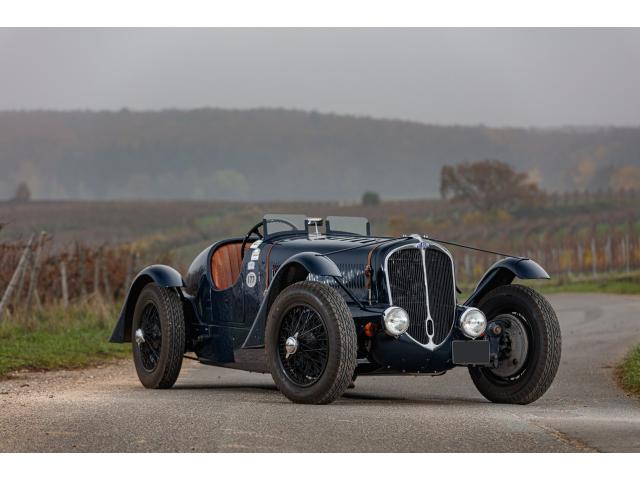1936 Delahaye 135 Spécial roadster biplace
- Brand: Delahaye
Emile Delahaye was one of the select few to exhibit in 1894 at the Paris Motor Show. Two years later, he entered the Paris-Marseille-Paris race and finished the 1,710km event in tenth place overall. Patronage from the Duchess d'Uzes brought further notoriety to Automobiles Delahaye, and in 1898, with financial backing from customer Georges Morane and his brother-in-law Leon Desmarais, the company was relocated to Paris. Also in 1898, Charles Weiffenbach was appointed Factory Director and Amedee Varlet became Chief Engineer.
In 1901, Emile Delahaye retired from the automobile business and the following year, the marque ceased its road racing activities. They continued their power boat racing which were powered by the Amedee Varlet designed double overhead camshaft marine powerplant which captured the Walter Speed Record. Other ingenious designs would follow, including the engine found in the Delahaye Type 44, which was produced from 1911 through 1914. It had a patent-protected narrow angle V6 engine mated to a four-speed manual transmission.
The Delahaye vehicles during the 1920s were positioned as mid-priced vehicles as Charles Weiffenbach worked to establish the company as France's premiere commercial vehicle manufacture. The Great Depression of the 1930s brought a decline in private sales. Some manufacturers turned their attention to municipal contracts which added competition for Delahaye. In response, Delahaye chose to go after the luxury car and sports sectors.
Engineer Jean Francois was tasked by Monsieur Charles (Charles Weiffenbach) to create a new Delahaye. The result of his work was displayed in October of 1933 at the Paris Salon. They were the Types 134 and 138 powered by an 18CV (3.2-litre) six-cylinder engine. One example, a Type 138 18CV Speciale with coachwork by Joseph Figoni, four worlds and eleven international class records at Montlhery in 1934. The following year, a Type 138 driven by Michel Paris and Marcel Mongin claimed fifth place overall (2nd-in-class) at the Le Mans 24-hours.
At the 1935 Paris Salon, Delahaye introduced the Type 135. In comparison to its predecessors, it was lower slung with box-section side rails and two cross members. It had a steel transmission tunnel, welded-in floor panels, independent front suspension comprised a lower transverse leaf spring and upper wishbones allied to longitudinal torque arms. The rear setup was a live axle supported by semi-elliptic leaf springs mounted outside the main chassis rails. There was a high geared worm and nut steering, and large cable-operated drum brakes with Bendix self-wrapping shoes. The Type 135 evolved further with the 96-horsepower Sport, 110 horsepower Coupe des Alpes, and the 120-horsepower Competition models constructed on several wheelbase sizes. The shortest platform measured 2.70m while the longest was 3.15m.
The Type 135 Special was the recipient of the Competition Court short chassis with a re-worked version of the Competition's 20CV, 3.6-liter engine. Eighteen examples were built between late 1935 and 1937, and it is believed that around thirteen remain in existence. As was customary at the time, Delahaye initially only provided the bare chassis. Thus, no two bodies were identical.
The Type 135 Special claimed numerous victories and racing successes during its competition career. It finished in 2nd through 5th place at the 1936 Grand Prix de 'lA.C.F., along with 7th, 11th, and 12th place. It was 2nd and 3rd at Spa 24-Hours, and 1st at both the Coupe d'Automne and Mount Ventoux. The following year, it was third at the Grand Prix de Pau and at the Mille Miglia. At the LeMans 24 Hour race, it finished 2nd and 3rd, following by a 1st at Donnington 12-hours. It was fifth at the RAC Tourist Trophy and a 1st and 2nd place finish at the Coupe d'Automne.
For the 1938 season, it finished 1st, 2nd and 4th at LeMans, and 2nd and 3rd at Paris 12-hours. It earned at 1st in class at the Grand Prix des Frontieres and a 1st overall at the Cote Lapize.
Part of the success of the Delahaye is attributed to the merger with Delage, which occurred just after the introduction of the Type 135. With this union, Delahaye inherited many of the marque's wealthy clients who were seeking an elegant and sporty automobile. The Type 135 was a suitable solution, with its agile chassis, 120 horsepower six-cylinder engine fitted with triple-Solex downdraft carburetors, and four-speed manual transmission.
Descriptions & pictures by conceptcarz & artcurial & sportscardigest
| Specification | |
| Production Start | 1936 |
| Country of origin | France |




























